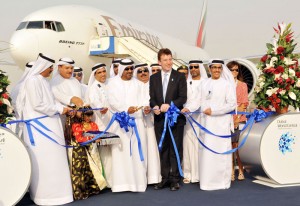By by Robeel Haq www.arabiansupplychain.com
Following years of preparation, Dubai finally opened the doors to its ground-breaking Al Maktoum International Airport last month, which is set to cement the Middle East’s position as a global aviation hub.
 Dubai marked its transition into a two-airport city last month, with the much-awaited launch of cargo operations at Al Maktoum International. A diverse range of cargo carriers have registered to operate in the airport – which is part of the multi-billion dollar Dubai World Central development – including Aban Air, ACI, Aerospace Consortium, Aviation Service Management, Coyne Airways, EuroAsian Services, Rus Aviation, Sonic Jet, SunGlobal, Skyline and United Aviation Services.
Dubai marked its transition into a two-airport city last month, with the much-awaited launch of cargo operations at Al Maktoum International. A diverse range of cargo carriers have registered to operate in the airport – which is part of the multi-billion dollar Dubai World Central development – including Aban Air, ACI, Aerospace Consortium, Aviation Service Management, Coyne Airways, EuroAsian Services, Rus Aviation, Sonic Jet, SunGlobal, Skyline and United Aviation Services.
To celebrate the launch, Sheikh Mohammed bin Rashid al-Maktoum, prime minister of the United Arab Emirates and the ruler of Dubai, and his son Sheikh Hamdan Maktoum, deputy ruler of Dubai, were provided a royal tour, alongside HH Sheikh Ahmed Bin Saeed Al Maktoum, president of Dubai Civil Aviation Authority and chairman of Dubai Airports.
“Phase one is the first step in a long infrastructure development project that over time will see our new airport transformed into the world’s largest global gateway and a multi-modal logistics hub, while playing an increasingly integral role in the ongoing economic and social development of Dubai,” comments Sheikh Ahmed.
“The inauguration of Al Maktoum International serves as a timely reminder to regional and international stakeholders of the strength of the vision of His Highness Sheikh Mohammed Bin Rashid Al Maktoum, vice president and prime minister of the UAE and ruler of Dubai, who continues to demonstrate an unwavering commitment to meeting the long-term infrastructure growth and capital requirements of our city.”
Sheikh Ahmed also reinforces the fact that Dubai World Central will support the emirate’s aviation, tourism, commercial and logistics requirements through 2050 and beyond. “The Government of Dubai remains fully committed to the timely realisation of the airport and Dubai World Central as whole. There is no doubt that this multi-modal logistics hub will provide significant benefits to the economy of Dubai and the wider region, particularly at a time when the transportation and logistics sector is playing an increasingly important role in the city’s rapidly diversifying economy.”
The initial phase of the airport will feature an A380 capable runway, 64 remote stands, a cargo terminal with annual capacity for 250,000 tonnes of freight, and a passenger terminal building designed to accommodate five million passengers per year. “Although it’s a long-term project, the need for a second airport in the near to mid-term is clear,” states Paul Griffiths, CEO of Dubai Airports. “Dubai International currently has capacity for 2.5 million tonnes of cargo, while volumes are expected increase to 3 million tonnes by 2015. On the passenger side we expect to see numbers skyrocket from the 41 million that passed through Dubai International in 2009 to 98 million by 2020 and 150 million by 2030.”
Griffiths adds that the new airport’s facilities and connectivity to the Jebel Ali Port and Jebel Ali Free Zone by a bonded road is being acknowledged by adopting airlines. “We are delighted with the response from cargo operators who are seizing the opportunity. DWC opened with 15 cargo airlines signed up and we expect that number to increase steadily over the next few months.”
The airport’s opening was preceded by the presentation of DWC’s official aerodrome certification to Sheikh Ahmed from Saif Mohammed Al Suwaidi, director general of General Civil Aviation Authority (GCAA), which followed a detailed aviation safety and security certification programme.
“This is the 8th International Aerodrome within the United Arab Emirates to receive a certification from the GCAA,” states Al Suwaidi. In addition to the aerodrome being certified, DWC was the first to obtain organisation certificates for air traffic services, communication, navigation and surveillance, aeronautical information services and aviation meteorology services.”
Once completed, Al Maktoum International will be the largest airport in the world, with five runways, four terminal buildings and annual facilitation for a total of 160 million passengers and 12 million tonnes of cargo.












